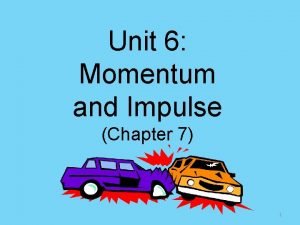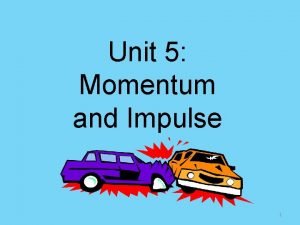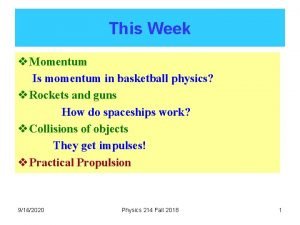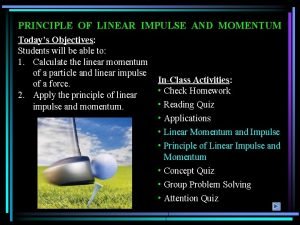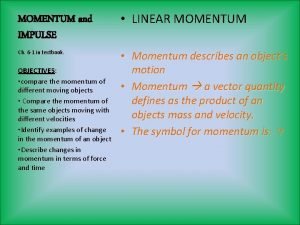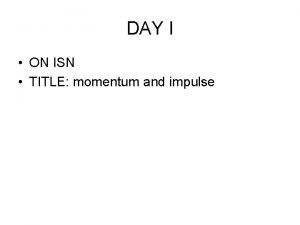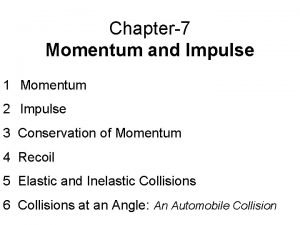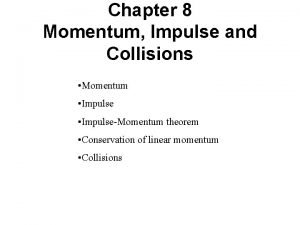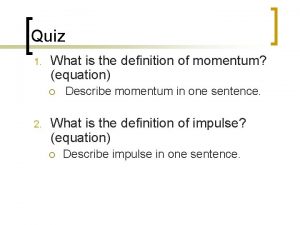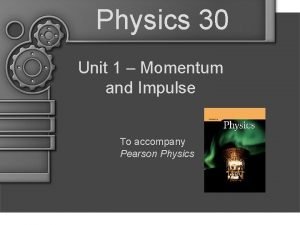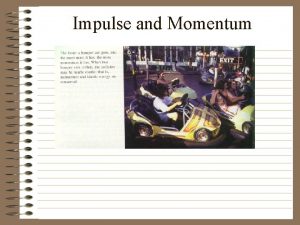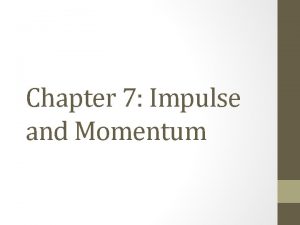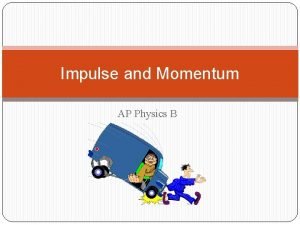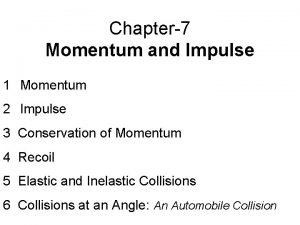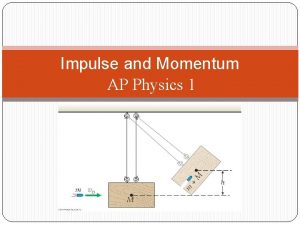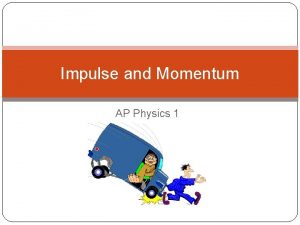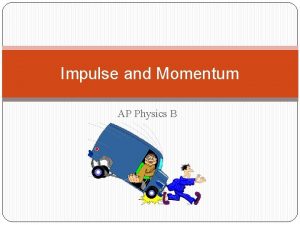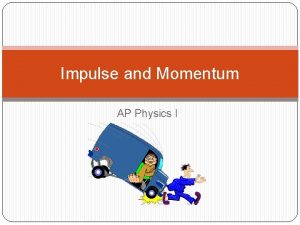Momentum and Impulse Introduction to Momentum Momentum is














- Slides: 14

Momentum and Impulse

Introduction to Momentum • Momentum is “inertia in motion. ” • Momentum is represented by “p”. • Momentum is the product of the mass and the velocity of an object. p = mv • Momentum is a vector quantity, meaning it has both magnitude and direction. Its direction is the same as its velocity. • Momentum is measured in units of kg m/s

Introduction to Impulse •

nd Remember Newton’s 2 Law? •

Conservation of Momentum • The total momentum of a system of objects must remain constant, unless outside forces act upon the system. • In a closed isolated system, momentum cannot be created nor destroyed. • Momentum can be transferred from one object to another, through an impulse (which changes the individual momentums). • Most studies of the conservation of momentum involve collisions.

Types of Collisions • Perfectly (completely) Inelastic Collisions -collisions where the objects stick together and move as one. The mass after the collision is equal to the sum of the masses and there is just one final velocity. Kinetic energy is not conserved since a lot of kinetic energy is converted to heat or other energies. • Perfectly (completely) Elastic Collisions – collisions where the objects bounce off of each other or separate. The objects return to their original shape. Kinetic energy is conserved. • Many collisions are neither completely elastic or inelastic. They separate after the collision but do not return to their original shape, so heat is created and kinetic energy is lost. • Separations or Explosions – the objects are at rest initially or are all one object and then they separate or explode.

Inelastic - Collisions that Stick • For collisions that stick, the after mass is the sum of all the masses, and there is a common or shared velocity. • Remember: pinitial = pfinal • m. Av. A+m. Bv. B= (m. A+m. B) vf

Elastic Collisions Before • Remember: pinitial = pfinal • m. Av. A+m. Bv. B =m. Av. A’+m. Bv. B’ • Usually mass remains the same after the collision but this does not always happen. • ’ means after the collision After

Perfectly Elastic Collisions • Momentum is conserved. • Kinetic energy is also conserved.

Separations/Explosions • Sometimes objects start as one and separate into two or more parts moving with individual velocities. – Example: A bullet is fired from a rifle. The bullet leaves the rifle with a velocity of vb and as a result the rifle has a recoil velocity of vr. – Solution: Before the rifle is fired the total momentum of the system is zero. 0 = mbvb’ + mrvr’ – Note: for total momentum to remain zero, the rifle’s momentum must be equal to but in the opposite direction to the bullet’s momentum. mbvb’ = - mrvr’

Why use an Airbag? • The change in momentum and thus the impulse stays the same whether or not you have an airbag (same mass and change in velocity). • So if you increase the time over which the force acts, the force of impact will decrease. • time increases, so force decreases Δp = F t m Δv = F t

Why follow through on your golf swing? • If you follow through, you are increasing the time over which the force acts on the ball. • For the same force, you would increase the impulse. • Increasing the impulse would result in a greater change in momentum. • For the same mass, there would be a greater change in velocity or acceleration. So the ball would go faster and/or farther (if a tree or other obstacle doesn’t get in its way!). • Follow through increases the time which increases the Δv or acceleration. F t = Δ p F t = m Δv t = m Δv F

Bug hitting windshield of bus

Bug hitting windshield of bus con’t
 Physics 03-01 work and the work-energy theorem
Physics 03-01 work and the work-energy theorem Unit 6 momentum and impulse
Unit 6 momentum and impulse Impulse law
Impulse law How to find initial momentum
How to find initial momentum Principle of linear impulse and momentum
Principle of linear impulse and momentum Linear impulse equation
Linear impulse equation Importance of momentum and impulse
Importance of momentum and impulse Poem about impulse and momentum
Poem about impulse and momentum How does impulse relate to momentum
How does impulse relate to momentum Importance of momentum and impulse
Importance of momentum and impulse Momentum and impulse formula sheet
Momentum and impulse formula sheet Momentum s.i unit
Momentum s.i unit Unit for momentum
Unit for momentum Whats the definition of momentum
Whats the definition of momentum Momentum and impulse physics 30
Momentum and impulse physics 30

